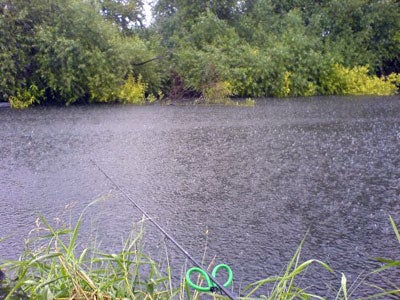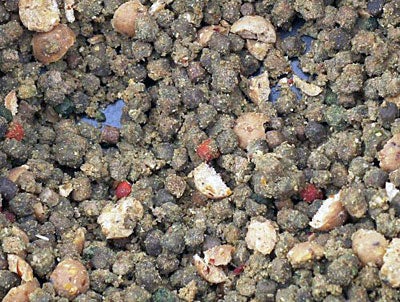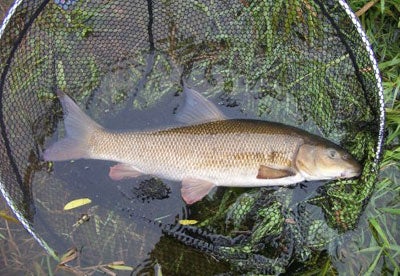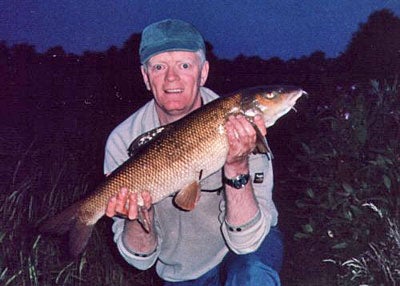| SEAN MEEGHAN | |
Fishing the Yorkshire Rivers for Barbel Part 3 – Summer FloodsDay One – Going Up! WHY AM I HERE? The rain is hammering on the roof of the car so hard that I can hardly hear myself think. The hot spell has broken with a vengeance and I’ve convinced myself that I need an afternoon on the Swale. There’s another car in the car park so there’s at least one other person as daft as me! I pluck up my courage and dash out into the downpour, cowering under the hatchback while I get ready.
I decide discretion is the better part of valour and take my brolly, committing myself to sitting it out in one spot. The river looks OK: 6 inches up with a nice colour and not too much rubbish coming down. I settle on a crease swim below a rush bed and try to feed a few pellets by catapult. No way! The fierce wind whips them across and down the swim. So it’ll have to be the bait dropper then! I put in a couple of droppers of mixed pellets and cover about half a pint of the same mix with some water for use in a cage feeder. Five minutes later I’m ready to go and I carefully pour the water off the pellets. The faster breakdown pellets have gone mushy and the halibut pellets are still hard. I also add a few broken boilies, which gives a good mix to press into the cage feeder.
I mark the water line with a twig, load the feeder and cast out into the crease. A 30g cage feeder holds bottom nicely as there is little water pressure on the line due to the sheltering rush bed. Ten minutes later I’m encouraged by what looks like a chub bite and on my next cast I connect with a nice chub of about 4lb. On returning the Chub I notice that my twig is now an inch under the water. It’s coming up fast! I cast out again and start to plan my move up the bank away from the rising waters. My plan is rudely interrupted by a screaming baitrunner and I’m connected to a decent barbel. I weigh her at 6lb 3oz, take a quick snap and she’s soon back in the river. Thoughts of moving take a back seat, so I move my gear as high as possible and re-cast. Two more barbel of about 4lb and 5 1/2 lb follow in quick succession before I’m forced to move back up the bank a bit to escape the swirling waters of the Swale. I take the opportunity to feed another couple of droppers of pellet to supplement my feeder-fed bait and I’m soon back fishing.
There’s a bit of a wait before a good barbel bite results in a chub of about 3lb. This Chub is followed by others at regular intervals before a short dry spell in the fading light decides me to call it a day. I’ve finished up with three barbel and eight Chub so its been a good afternoon’s fishing. Lessons Learnt
Two days later on a bright Friday afternoon I’m back on the Swale. The car park is full, so it looks like a few other people have decided that conditions will be good! The river has dropped and is about six inches up with a fair bit of colour. It looks like there is also a bit of ‘tea stain’, a peaty suspension which affects the Swale in summer floods. The swim I fished on Wednesday is free, but it looks like it’s been fished earlier in the day. I decide to give it a go anyway. I catapult a few pouches of mixed pellet into the swim and leave some to soak for my feeder. I unfold the rod, clip on a cage feeder, push an 8mm halibut pellet into the band that is already on the hook and I’m ready to go. I drain the pellet mix, press some into my feeder and cast. This whole procedure has taken less than five minutes, including setting up the rod rests and chair. It’s important not to leave the pellets to soak too long, so if you’re going to take longer to get ready, drain your pellets after about five minutes. A short wait results in a good pull and a chub of about 3lb. After this I’m plagued with twitchy chub bites. They are obviously nervous, probably because the guy who fished the swim before me caught a few. I give it an hour without another fish and decide to move. The barbel are just not playing and three more moves to productive swims produce nothing. My mate Mick follows a similar strategy and eventually lands a barbel of about 5lbs. As the light fades I give it best and return home.
Lessons Learnt
|














